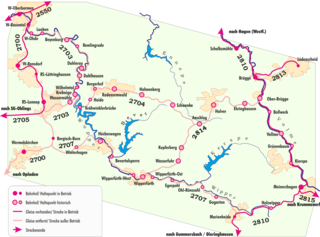
The Volme is a river in North Rhine-Westphalia, Germany, and is a tributary of the river Ruhr. It is 50.5 kilometres (31.4 mi) long, of which about 21 km (13 mi) lie within the city limits of Hagen. Its largest tributary is the Ennepe.

Gummersbach is a town in the state of North Rhine-Westphalia, Germany, being the district seat of the Oberbergischer Kreis. It is located 50 kilometres (31 mi) east of Cologne.

Wiehl is a municipality in the Oberbergischer Kreis, in North Rhine-Westphalia, Germany. It is located approximately 41 km east of Cologne. The neighbouring municipalities Reichshof, Waldbröl, Nümbrecht, Much, Engelskirchen and Gummersbach border on the town.

Waldbröl is a town in the southern part of the Oberbergischer Kreis, in North Rhine-Westphalia, Germany.

Morsbach is a municipality in Oberbergischer Kreis, a district in North Rhine-Westphalia near the border of Rhineland-Palatinate in Germany. In 2015, Morsbach's population was 10,600. The central village, also named Morsbach, has a population of 3,400. With a number of buildings dating back to the 12th century, it is a popular spot for hikers and other nature lovers.

Marienheide is a municipality in the Oberbergischer Kreis, in North Rhine-Westphalia, Germany.

Köln Messe/Deutz station is an important railway junction for long-distance rail and local services in the Deutz neighborhood of Cologne in the German state of North Rhine-Westphalia. It is situated close to the eastern bank of the Rhine and connected via the Hohenzollern Bridge to Köln Hauptbahnhof, the city's main station, which is just a few hundred metres away. The Cologne Trade Fair grounds are directly north of the station, hence the Messe in the station's name. The Deutz/Messe station of the Cologne Stadtbahn is nearby and connected to this station by a pedestrian tunnel.

Siegburg/Bonn station, in the town of Siegburg, North Rhine-Westphalia, Germany, is on the Cologne–Frankfurt high-speed rail line and the Sieg Railway. It was rebuilt for the high-speed line and is connected to Bonn by the Siegburg line of the Bonn Stadtbahn. It is in the network area of the Verkehrsverbund Rhein-Sieg.

Köln Süd station is located in the southwestern edge of the Innenstadt of Cologne in the district of Neustadt-Süd in the German state of North Rhine-Westphalia. It is located between the streets of Luxemburger Straße and Zülpicher Straße. The station is a stop for regional services on the West Rhine Railway. The Cologne freight railway bypass branches off from the station over the South Bridge; it is also used as needed by passenger trains. The station has four platform tracks at two island platforms and two tracks without platforms, which are used by the intensive freight traffic. It is classified by Deutsche Bahn as a category 4 station.

The Sieg Railway (German: Siegstrecke is a 100-kilometre long, electrified German main line railway between Cologne-Deutz via Porz, Troisdorf, Siegburg, Hennef, Au, Betzdorf to Siegen with a through service to Cologne Hauptbahnhof. Although most of it is two-track, two five-kilometre sections are only single track. Both ends of the line are in the state of North Rhine-Westphalia, but between Au and Niederschelden it runs through Rhineland-Palatinate. It is one of the oldest lines in Germany, opened between 1859 and 1862 by the Cologne-Minden Railway Company.
Agger Valley Railway (Aggertalbahn) is the established name of two railway lines in the German state of North Rhine-Westphalia:

The Siegburg–Olpe railway or Agger Valley Railway is a single-tracked, non-electrified branch line in the German state of North Rhine-Westphalia. Part of a direct link from Cologne, only the section from Overath to Gummersbach-Dieringhausen is still in operation. The section of line from Siegburg to Overath and from Dieringhausen to Olpe are closed.

The Cologne–Lindlar railway is a formerly 45 km long, partly disused railway line from Mülheim via Bergisch Gladbach, Bensberg, Rösrath, Hoffnungsthal and Immekeppel to Lindlar in the German state of North Rhine-Westphalia.

Wuppertal-Ronsdorf station is a station on the Wuppertal-Oberbarmen–Solingen railway in the German state of North Rhine-Westphalia. It is classified by Deutsche Bahn as a category 5 station. It is unusual in that it was once connected to lines with three different gauges.

The Hagen–Dieringhausen railway is a mostly single-track and non-electrified railway line from Hagen Hauptbahnhof via Lüdenscheid-Brügge, Meinerzhagen and Gummersbach to Gummersbach-Dieringhausen in the German state of North Rhine-Westphalia.
The Cologne–Overath railway is a single-track, non-electrified railway in the German state of North Rhine-Westphalia. It was opened in 1910 to connect the historic Siegburg–Olpe railway directly to Cologne and required the construction of the Hoffnungsthal tunnel. The section from Hoffnungsthal to Rösrath partly used the track of the Cologne–Lindlar railway, which is now largely disused west of Bergisch Gladbach. The line, like the Siegburg–Olpe line, is also called the Aggertalbahn, although it leaves the valley of the Agger not far from Overath.

Gummersbach-Dieringhausen station has existed since 1887 and it made the formerly insignificant village of Dieringhausen an important regional town in the German state of North Rhine-Westphalia. Its former railway lines, railway depot and railway settlements still dot the village.
The Oberbergische Bahn is a Regionalbahn rail service running between Cologne Hansaring and Lüdenscheid in the German state of North Rhine-Westphalia (NRW).

The Brügge–Lüdenscheid railway is a single-track, non-electrified branch line in the German state of North Rhine-Westphalia. The 7 km-long line climbs from Lüdenscheid-Brügge station on the Hagen–Dieringhausen railway to Lüdenscheid station.

Lüdenscheid-Brügge station is on the Hagen–Dieringhausen railway from Hagen Hauptbahnhof to Dieringhausen station in the German state of North Rhine-Westphalia. It is classified by Deutsche Bahn as a category 7 station. Because of the branch line to Lüdenscheid, it is classified as a separation station. The station is located on the edge of the Lüdenscheid hamlet of Brügge. There is an island platform with tracks which connects with the bus stop at ground level. The station is known nationally for its elevated disused but preserved signalbox. The station was called Brügge (Westfalen) until 10 December 2017.






















